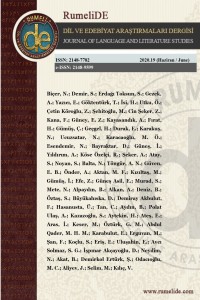Fathers, sons, shame and remorse: Khaled Hosseini’s The Kite Runner and Orhan Pamuk’s Kırmızı Saçlı Kadın (The Red-Haired Woman)
Abstract
Khaled Hosseini’s The Kite-Runner (Uçurtma Avcısı) (2003) and Orhan Pamuk’s The Red-Haired Woman (Kırmızı Saçlı Kadın) (2016) show many parallelisms in plot and theme with their portrayal of several characters who are suffering with remorse and shame for the disgraceful acts they committed. who are seeking ways to alleviate their pain and to recover from their trauma. With the tragic transformation of two cities, war-torn Kabul and booming Istanbul in the background, the characters’ lives are also complicated with medical problems like infertility, insomnia and severe diseases as the characters who are unable to share secrets attempt to find solace in literature. The prevailing grim atmosphere in the novels is further accentuated by particularly the sense of betrayal which agonizes both the victims and the perpetrators in different ways and to varying degrees. Repeated references and allusions to the stories like Rostam and Sohrab by Ferdowsi and Oedipus Rex by Sophocles which cover patricide and filicide lines aggravates the dominant feeling of shame and regret, and underlines failing relationships between fathers and their sons. The inability and indifference of the father characters, Baba and Akın, to show affection, love and care for their sons is partially compensated by surrogate fathers like Rahim Khan and Mahmut Usta, and Cem and Amir suffer for long years. Although both Cem and Amir are successful in their occupations and make very good marriages, neither of them can forget about their shameful acts in the past, share it with anybody or be happy.
References
- Brooks, G. (2017, October 16). In Orhan Pamuk’s new novel, a youthful obsession yields a haunted life. The New York Times. https://www.nytimes.com/2017/10/16/books/review/red-haired-woman-orhan-pamuk.html
- Genç, K. (2017, November 16). Fathers and sons. The Nation. https://www.thenation.com/article/archive/orhan-pamuks-fathers-and-sons/
- Göknar, E. (2017, August 22). A Turkish woman in the Oedipus complex: Orhan Pamuk’s “The Red-Haired Woman.” Los Angeles Review of Books. https://lareviewofbooks.org/article/a-turkish-woman-in-the-oedipus-complex-orhan-pamuks-the-red-haired-woman/
- Günay-Erkol, Ç. (2019). Insidious trauma and traumatized masculinities in Orhan Pamuk’s “The Red-Haired Woman.” In F. Çiçekoğlu, & Ö.Turan (Eds.), The dubious case of a failed coup: Militarism, masculinities, and 15 july in Turkey (pp.169-187). Palgrave Macmillan.
- Hoby, H. (2013, June 1). Interview with Khaled Hosseini: 'If I could go back now, I'd take The Kite Runner apart'. The Guardian. https://www.theguardian.com/books/2013/jun/01/khaled-hosseini-kite-runner-interview
- Hosseini, Khaled. (2003). Uçurtma avcısı. (Çev. P.Özgören). Everest.
- Nayepour, K. (2018). The uses of storytelling in Khaled Hosseini’s “The Kite Runner.” Hacettepe University Journal of Faculty of Letters, 35(1), 52-60.
- O’Brien, S. (2018). Translating trauma in Khaled Hosseini’s “The Kite Runner.” Transnational Literature, 10(2), 1-12. http://fhrc.flinders.edu.au/transnational/home.html+0
- Pamuk, O. (2016). Kırmızı saçlı kadın (The Red-Haired Woman). Yapı Kredi Yayınları
- Preston, A. (2017, September 3). The Red-Haired Woman review – Orhan Pamuk finds truth at the bottom of a well. The Observer. https://www.theguardian.com/books/2017/sep/03/the-red-haired-woman-by-orhan-pamuk-review-secrets-of-fatherhood
Babalar, oğullar, utanç ve pişmanlık: Khaled Hosseini’nin Uçurtma Avcısı ve Orhan Pamuk’un Kırmızı Saçlı Kadın’ı
Abstract
Khaled Hosseini’nin Uçurtma Avcısı (2003) ve Orhan Pamuk’un Kırmızı Saçlı Kadın (2016) romanları, geçmişte işledikleri yüz kızartıcı eylemlerinden dolayı pişmanlık ve utanç duyan, acılarını dindirmek ve travmalarından kurtulmak için çareler arayan pek çok karakter tasviri ile olay örgüsü ve tema olarak oldukça paralellik göstermektedir. Hızla büyüyen İstanbul ve savaşta yakılmış-yıkılmış Kabil’in trajik değişiklikleri arka planda yer alırken, karakterlerin yaşamları kısırlık, uykusuzluk, ciddi hastalıklar gibi tıbbi sorunlarla daha da karmaşıklaşır ve sorunlarını kimseyle paylaşamayan karakterler edebiyatta teselli arar. Romanlardaki hakim olan tatsız atmosfer, hem eylemi gerçekleştirenleri hem de kurbanları farklı biçimlerde ve farklı derecelerde etkileyen ihanet duygusu ile daha da pekiştirilir. Baba katli ve evlat katlinin işlendiği Firdevsi’nin Rüstem ve Sührab ile Sofokles’in Oidipus’u gibi hikayelere sıklıkla yapılan atıflar ve göndermeler baskın olan utanç ve pişmanlık duygusunu artırır ve babalar ve oğullar arasındaki yürümeyen ilişkilerin altını çizer. Akın ve Baba’nın baba olarak şefkat, sevgi ve ilgi göstermedeki yetersizlikleri ve ilgisizlikleri baba vekili olarak betimlenen Mahmut Usta ve Rahim Han tarafından ancak kısmen telafi edilebilir ve Cem ve Amir uzun yıllar bu sevgisizliğin ceremesini çekerler. Her ne kadar işlerinde başarılı olsalar ve çok iyi evlilikler yapsalar da ne Cem ne de Amir geçmişlerinde sebep oldukları utanç verici eylemleri her ne kadar unutmaya çalışsalar da unutabilir, çok uzun yıllar kimseyle paylaşabilir ve tam anlamıyla mutlu olabilir.
References
- Brooks, G. (2017, October 16). In Orhan Pamuk’s new novel, a youthful obsession yields a haunted life. The New York Times. https://www.nytimes.com/2017/10/16/books/review/red-haired-woman-orhan-pamuk.html
- Genç, K. (2017, November 16). Fathers and sons. The Nation. https://www.thenation.com/article/archive/orhan-pamuks-fathers-and-sons/
- Göknar, E. (2017, August 22). A Turkish woman in the Oedipus complex: Orhan Pamuk’s “The Red-Haired Woman.” Los Angeles Review of Books. https://lareviewofbooks.org/article/a-turkish-woman-in-the-oedipus-complex-orhan-pamuks-the-red-haired-woman/
- Günay-Erkol, Ç. (2019). Insidious trauma and traumatized masculinities in Orhan Pamuk’s “The Red-Haired Woman.” In F. Çiçekoğlu, & Ö.Turan (Eds.), The dubious case of a failed coup: Militarism, masculinities, and 15 july in Turkey (pp.169-187). Palgrave Macmillan.
- Hoby, H. (2013, June 1). Interview with Khaled Hosseini: 'If I could go back now, I'd take The Kite Runner apart'. The Guardian. https://www.theguardian.com/books/2013/jun/01/khaled-hosseini-kite-runner-interview
- Hosseini, Khaled. (2003). Uçurtma avcısı. (Çev. P.Özgören). Everest.
- Nayepour, K. (2018). The uses of storytelling in Khaled Hosseini’s “The Kite Runner.” Hacettepe University Journal of Faculty of Letters, 35(1), 52-60.
- O’Brien, S. (2018). Translating trauma in Khaled Hosseini’s “The Kite Runner.” Transnational Literature, 10(2), 1-12. http://fhrc.flinders.edu.au/transnational/home.html+0
- Pamuk, O. (2016). Kırmızı saçlı kadın (The Red-Haired Woman). Yapı Kredi Yayınları
- Preston, A. (2017, September 3). The Red-Haired Woman review – Orhan Pamuk finds truth at the bottom of a well. The Observer. https://www.theguardian.com/books/2017/sep/03/the-red-haired-woman-by-orhan-pamuk-review-secrets-of-fatherhood
Details
| Primary Language | Turkish |
|---|---|
| Subjects | Literary Studies |
| Journal Section | Turkish language, culture and literature |
| Authors | |
| Publication Date | June 21, 2020 |
| Published in Issue | Year 2020 Issue: 19 |


